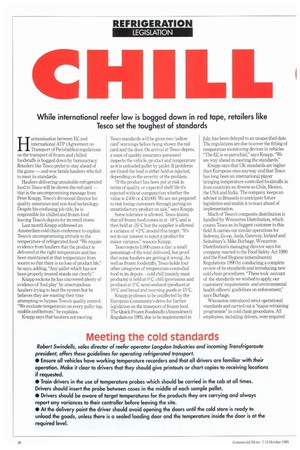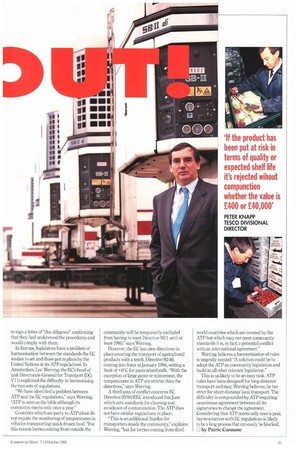CH
Page 32

Page 33

If you've noticed an error in this article please click here to report it so we can fix it.
While international reefer law is bogged down in red tape, retailers like Tesco set the toughest of standards
Harmonisation between EC and international ATP (Agreement on Transport of Perishables) regulations on the transport of frozen and chilled foodstuffs is bogged down by bureaucracy. Retailers like Tesco prefer to stay ahead of the game — and woe betide hauliers who fail to meet its standards.
Hauliers delivering unsaleable refrigerated food to Tesco will be shown the red card — that is the uncompromising message from Peter Knapp, Tesco's divisional director for quality assurance and non-food technology. Despite his confusing job title, he is responsible for chilled and frozen food leaving Tesco's depots for its retail stores.
Last month Knapp addressed an Amsterdam cold chain conference to explain Tesco's uncompromising attitude to the temperature of refrigerated food: "We require evidence from hauliers that the product is delivered at the right temperature and has • been maintained at that temperature from source so that there is no loss of product life," he says, adding, "Any pallet which has not been properly treated stands out clearly" Knapp reckons he has uncovered plenty of evidence of 'foul play' by unscrupulous hauliers trying to beat the system but he believes they are wasting their time attempting to bypass Tesco's quality control. "We evaluate temperature on every pallet top, middle and bottom," he explains.
Knapp says that hauliers not meeting Tesco standards will be given two 'yellow card' warnings before being shown the red card and the door. On arrival at Tesco depots, a team of quality assurance personnel inspects the vehicle, product and temperature as it is unloaded pallet by pallet. If problems are found the load is either held or rejected, depending on the severity of the problem.
"If the product has been put at risk in terms of quality or expected shelf life it's rejected without compunction whether the value is £400 or £40,000. We are not prepared to risk losing customers through putting an unsatisfactory product on sale," says Knapp.
Some tolerance is allowed. Tesco insists that all frozen food comes in at -18°C and is then held at -25°C but the supplier is allowed a variance of +2°C around this target. "It's not in our interest to reject a product for minor variance," reasons Knapp.
Tesco rejects 1,000 cases a day: a small percentage of the total delivered, but proof that some hauliers are getting it wrong. As well as frozen foodstuffs, Tesco holds four other categories of temperature.controlled food in its depots—cold chill (mainly meat products) is held at 0°C; chill (provisions and produce) at 3°C; semi-ambient (produce) at 10°C and bread and morning goods at 15°C.
Knapp professes to be unaffected by the European Community's drive for further legislation on the transport of frozen food. The Quick Frozen Foodstuffs (Amendment) Regulations 1993, due to be implemented in July, has been delayed to an unspecified date. The regulations are due to cover the fitting of temperature monitoring devices in vehicles "The EC is so parochial," says Knapp, "We are way ahead in meeting the standards."
Knapp says that UK standards are higher than European ones anyway and that Tesco has long been an international player bringing temperature controlled foodstuffs in from countries as diverse as Chile, Mexico, the USA and India. The company keeps an adviser in Brussels to anticipate future legislation and enable it to react ahead of implementation.
Much of Tesco's composite distribution is handled by Wincanton Distribution, which counts Tesco as its biggest customer in this field. It carries out similar operations for Safeway, Co-op, Asda, Gateway, Iceland and Sainsbury's. Mike Burbage, Wincanton Distribution's managing director says his company reacted to the Food Safety Act 1990 and the Food Hygiene (amendments) Regulations 1990 by conducting a complete review of its standards and introducing new cold chain procedures. "These took account of the standards we wished to apply, our customers' requirements and environmental health officers' guidelines on enforcement," says Burbage.
Wincanton introduced strict operational standards and carried out a "major retraining programme" in cold chain procedures. All employees, including drivers, were required to sign a letter of "due diligence" confirming that they had understood the procedures and would comply with them.
In Europe, legislators have a problem of harmonisation between the standards the EC wishes to set and those put in place by the United Nations in its ATP regulations. In Amsterdam, Luc Werring, the EC's head of unit Directorate-General for Transport (DG VU) explained the difficulty in harmonising the two sets of regulations.
"We have identified a problem between ATP and the EC regulations," says Werring, "ATP is seen as the bible although its committee meets only once a year."
Countries which are party to ATP alone do not require the monitoring of temperatures in vehicles transporting quick frozen food. "For this reason lorries coming from outside the community will be temporarily excluded from having to meet Directive 92/1 until at least 1995," says Werring.
However, the EC has nine directives in place covering the transport of agricultural products with a tenth, Directive 92/46, coming into force in January 1994, setting a limit of +6°C for pasteurised milk. "With the exception of large game or mincemeat, the temperatures in ATP are stricter than the directives," says Werring.
A third area of conflict concerns EC Directive 93/94/EEC introduced this June which sets standards for cleaning and avoidance of contamination. The ATP does not have similar regulations in place.
"This is an additional burden for transporters inside the community," explains Werring, "but for lorries coming from third world countries which are covered by the ATP but which may not meet community standards iris, in fact, a potential conflict with an international agreement."
Werring believes a harmonisation of rules is urgently needed: "A solution could be to adopt the ATP as community legislation and build in all other relevant legislation."
This is unlikely to be an easy task. ATP rules have been designed for long-distance transport and may, Werring believes, be too strict for short-distance local transport. The difficulty is compounded by ATP requiring unanimous agreement between all its signatories to change the agreement. Considering that ATP meets only once a year, harmonisation with EC regulations is likely to be a long process that can easily be blocked. 0 by Patric Curmane




























































































